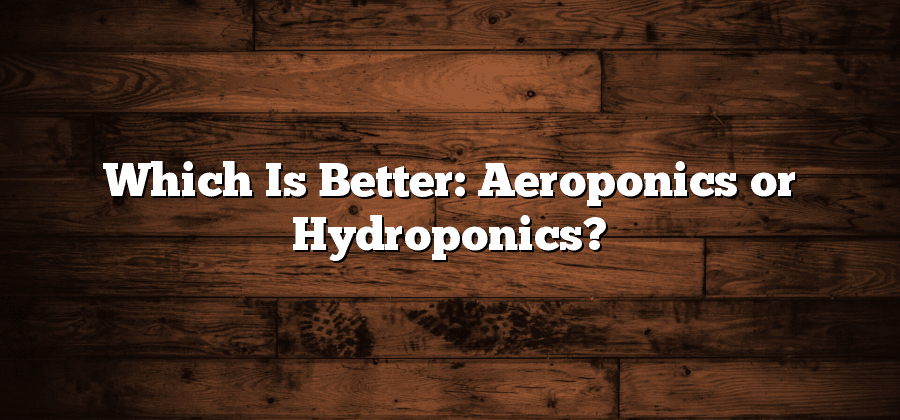Advantages of Aeroponics over Hydroponics
Aeroponics offers several distinct advantages over hydroponics. Firstly, aeroponics provides unparalleled oxygenation to the plant roots, allowing for more efficient nutrient uptake and faster growth rates. The absence of a solid growth medium in aeroponics systems eliminates the risk of soil-borne diseases, ensuring healthier and more robust plants.
Additionally, aeroponics allows for precise control over the nutrient delivery system. By misting or spraying the roots with a nutrient-rich solution, the plant receives exactly what it needs, eliminating any waste or overfeeding. This targeted approach not only saves on nutrient costs but also minimizes environmental impact, making aeroponics a more sustainable choice in comparison to hydroponics.
In conclusion, the advantages of aeroponics over hydroponics lie in its superior oxygenation capabilities and precise nutrient delivery system. With these benefits, aeroponics offers an efficient and sustainable solution for cultivating plants.
Advantages of Hydroponics over Aeroponics
Hydroponics, a soilless cultivation method, offers numerous advantages over its counterpart, aeroponics. One significant advantage lies in its simplicity and ease of use. Unlike aeroponics, which requires highly specialized equipment and a complex setup, hydroponic systems are relatively straightforward to set up and maintain. This makes hydroponics a more accessible option for both experienced growers and beginners entering the world of soilless cultivation.
Additionally, hydroponics provides a higher degree of control over the plant’s growth environment. With the ability to monitor and adjust variables such as nutrient concentration, pH levels, and water availability, growers can ensure optimal conditions for their crops. This precise control allows for better nutrient uptake and a reduced risk of nutrient deficiencies or excesses, leading to healthier and more productive plants. Furthermore, due to the simplicity and flexibility of hydroponic systems, it is easier to experiment with different nutrient mixes and growing techniques to meet specific plant requirements.
Differences in Nutrient Delivery Systems
In the world of soilless cultivation methods, the differences in nutrient delivery systems between aeroponics and hydroponics play a crucial role in determining their effectiveness. While both systems ensure the plants receive the necessary nutrients, they employ distinct approaches.
Hydroponics typically utilizes a recirculating nutrient solution, where essential elements are dissolved in water and directly delivered to the plant roots. This method allows for easy control of the nutrient concentration, pH levels, and overall health of the solution. By providing a constant and regulated flow of nutrients, hydroponics ensures that plants have access to an optimal supply, resulting in healthy growth and high yields. Additionally, since the nutrient solution is recirculated, hydroponics proves to be a water-conservative system, reducing wastage and promoting sustainability.
Comparison of Plant Growth Rates
A fundamental aspect to consider when choosing between aeroponics and hydroponics is the comparison of plant growth rates. Both systems offer unique advantages for maximizing plant growth and yields. However, it is vital to understand the key differences in terms of growth rates to make an informed decision.
In aeroponics, plant growth rates are often accelerated due to the direct exposure of roots to the nutrient-rich mist. This method allows plants to absorb essential nutrients and water more efficiently, promoting faster growth and development. Furthermore, the high oxygen levels in the root zone further enhance nutrient uptake, resulting in robust and healthy plants. The precise control of environmental factors, such as temperature and humidity, in aeroponic systems also contributes to optimal growth rates.
Water and Nutrient Efficiency in Aeroponics
Aeroponics is a cutting-edge farming technique that offers exceptional water and nutrient efficiency. Unlike traditional soil-based cultivation or hydroponics, aeroponics allows for the precise delivery of water and nutrients directly to the plant’s roots. This targeted application ensures that the plants receive exactly what they need, minimizing wastage and optimizing resource utilization.
In aeroponics systems, plants are suspended in air, with their roots exposed to a fine mist or fog of nutrient-rich water. This highly efficient method not only conserves water but also allows for the effective absorption of nutrients by the plants. Compared to hydroponics, where plants are grown in a substrate and require a constant flow of water, aeroponics eliminates the need for excessive volumes of water, making it a more sustainable and environmentally friendly choice. With aeroponics, water and nutrient efficiency go hand in hand, ensuring that plants receive the perfect balance of resources for optimal growth and development.






